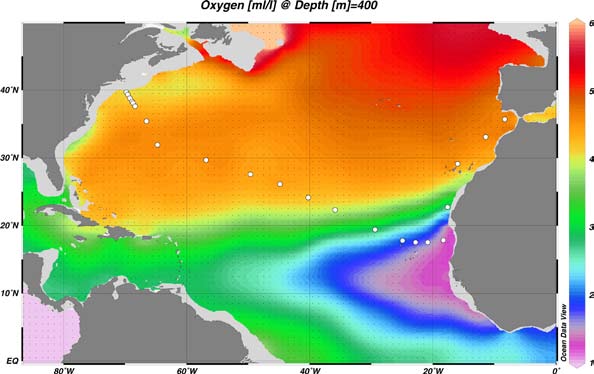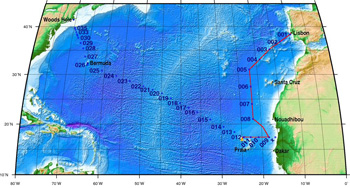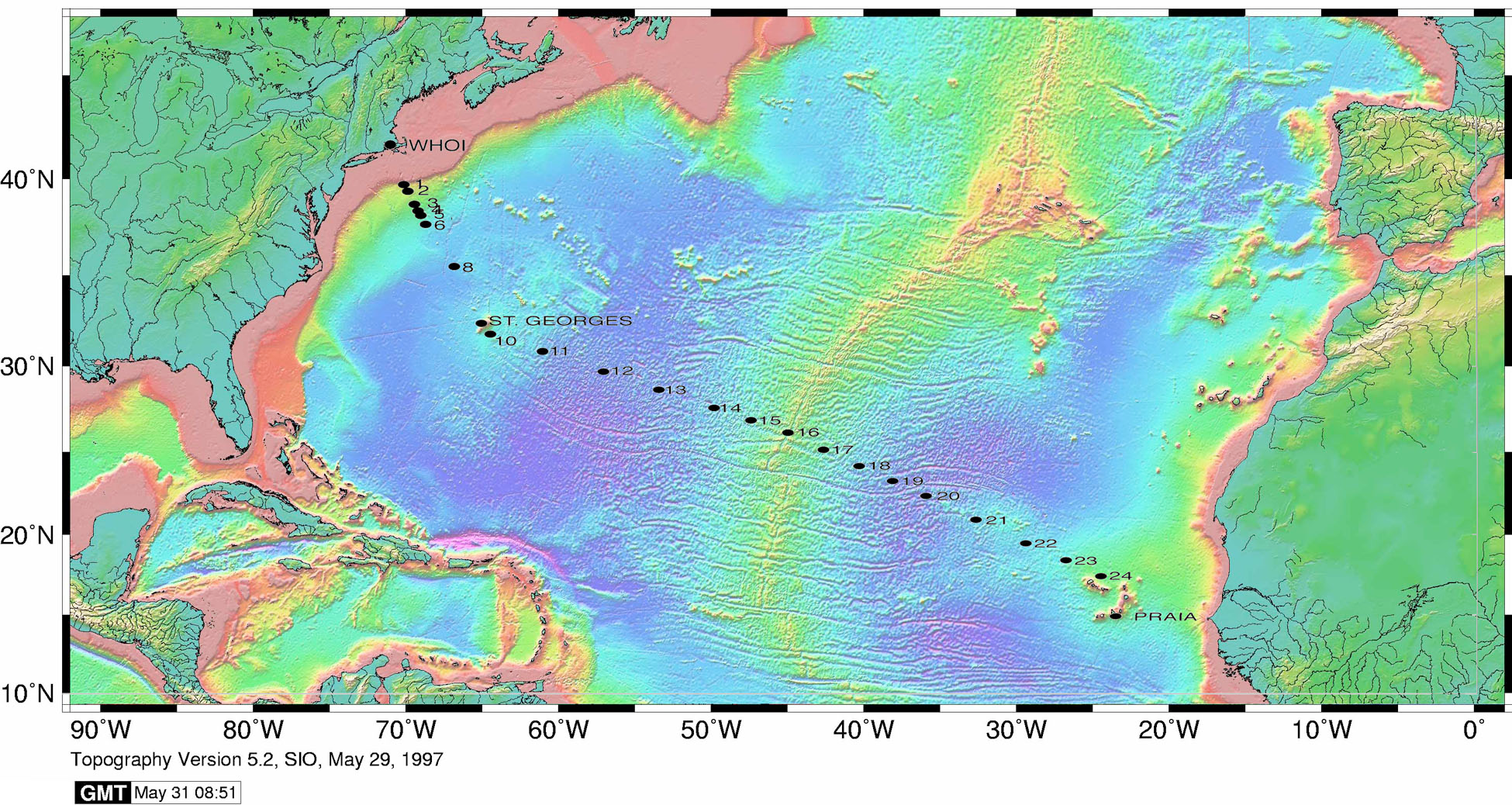Total aerosol iron isotope ratios from the 2011 GA03 U.S. GEOTRACES North Atlantic Transect Cruise, KN204-01, on R/V Knorr
Project
Program
| Contributors | Affiliation | Role |
|---|---|---|
| John, Seth G. | University of South Carolina | Principal Investigator |
| Conway, Timothy M. | University of South Carolina | Scientist |
| Rauch, Shannon | Woods Hole Oceanographic Institution (WHOI BCO-DMO) | BCO-DMO Data Manager |
Abstract
(Sampling and Digestion methods are reproduced directly from http://bco-dmo.org/dataset/3865.)
Sample Collection:
Aerosol samples were collected on acid-washed Whatman 41 (W41) cellulose ester filter papers deployed in one of two high-volume aerosol samplers (model 5170-VBL, Tisch Environmental) deployed simultaneously operating at approximately 1.2 cubic meters air per minute. The aerosol samplers were deployed on the ship's flying bridge (14 meters above sea level) as high off the water as possible. Contamination from the ship's stack exhaust was avoided by controlling aerosol sampling with respect to wind sector and wind speed using an anemometer interfaced with a Campbell Scientific CR800 datalogger and PC. The samplers were allowed to run when the wind was +/- 60 degrees from the bow and > 0.5 meters per second (m/s). When the wind failed to meet these two criteria, the motors were shut off automatically and not allowed to restart until the wind met both the speed and direction criteria for 5 continuous minutes. The anemometer was deployed nearby on a separate pole in 'free air' where turbulence from the wind crossing the bow did not cause the wind vane to wobble excessively. Filters for total aerosols were stored frozen prior to processing.
Sample Digestion:
The W41 filter discs were digested in tightly capped Teflon vials using sequential additions of concentrated acid solutions [nitric acid (Optima) and hydrofluoric acid (Optima)] at 150 degrees C (Morton et al., 2013). Any solution remaining after each digestion step was heated to dryness. After the final digestion and dry down, the samples were re-dissolved with 0.32 M nitric acid for analysis using inductively coupled plasma mass spectrometry (ICP-MS; Agilent 7500CS and Thermo Element 2). All filter digestions were performed under a Class 100 laminar flow hood at the National High Magnetic Field Laboratory at Florida State University (FSU).
Blank solutions for the acid digestions were prepared by digesting W41 discs that had been deployed in the aerosol samplers for 1 hour while not in operation. For example, blanks accounted for 65.6 ± 0.52 nanograms per cubic meter (ng m-3) air Fe (representing an average of 0.09 ± 0.001% of the Fe sample concentrations).
Iron Isotope Analysis:
At the University of South Carolina (USC), aliquots of total-digested aerosol filters were evaporated to dryness, spiked with an 57-58 Fe double spike, and purified by AGMP-1 Column Chemistry. Methods followed Conway et al. (2013). Following purification, iron stable isotope ratios were determined by Neptune multi-collector ICPMS. Fe was analzyed using HR mode. Each sample was analyzed twice and the mean isotope ratios are expressed here relative to international isotope standard IRMM-014. Instrumental and procedural fractionation were corrected for using a double spike reduction scheme. Samples were corrected for blank contribution based on the measured mass of Fe and measured Fe isotope signatures of blank filters (see Conway et al., 2019 for more details).
We express uncertainty conservatively (2 sigma) as 0.05 permil (1 sigma is 0.025) based on replicate seawater and aerosol sample measurements (see Conway et al., 2019) .
Data were processed in Excel. Data follow the recommended GEOTRACES (SeaDataNet) quality flag scheme. For more information on SeaDataNet flags, see: https://www.geotraces.org/geotraces-quality-flag-policy/ and https://www.seadatanet.org/Standards/Data-Quality-Control.
SeaDataNet quality flag definitions:
0 = No quality control;
1 = Good value;
2 = Probably good value;
3 = Probably bad value;
4 = Bad value;
5 = Changed value;
6 = Value below detection;
7 = Value in excess;
8 = Interpolated value;
9 = Missing value;
A = Value phenomenon uncertain.
- Imported original file "KN204_dataTemplate.xlsx" into the BCO-DMO system.
- Joined the cruise event log to the data file based on Sample Id.
- Populated the following columns with data from the event log: Station_ID, Event_ID, Start_Time, End_Time.
- Removed empty columns: Gear ID, Rosette Position, and Sample Depth.
- Renamed fields to comply with BCO-DMO naming conventions.
- Changed format of the date columns from %d-%m-%y to %m-%d-%y to match the KN199-04 data.
- Created Date-Time UTC fields in ISO 8601 format.
- Made longitude values negative (to indicate West direction).
- Corrected the end longitude for samples 6677b and 6667c.
- Saved final file as "958934_v1_bulk_areosol_fe_isotopes_kn204-01.csv".
Relationship Description: Both cruises comprised the GA03 expedition.
Relationship Description: Contains dissolved Fe isotope ratios for the water column same deployments.
Relationship Description: Total aerosol trace elemental concentrations from same samples.
| Parameter | Description | Units |
| Station_ID | Station number; added by BCO-DMO using the cruise event log | unitless |
| Event_ID | Event number; added by BCO-DMO using the cruise event log | unitless |
| Start_ISO_DateTime_UTC | Date and time (UTC) at start of sample collection in ISO 8601 format | unitless |
| Start_Date_UTC | Date at start of sample collection | unitless |
| Start_Time_UTC | Time (UTC) at start of sample collection; added by BCO-DMO using the cruise event log | unitless |
| End_ISO_DateTime_UTC | Date and time (UTC) at end of sample collection in ISO 8601 format | unitless |
| End_Date_UTC | Date at end of sample collection | unitless |
| End_Time_UTC | Time (UTC) at end of sample collection; added by BCO-DMO using the cruise event log | unitless |
| Start_Latitude | Latitude at start of sample collection | decimal degrees |
| Start_Longitude | Longitude at start of sample collection | decimal degrees |
| End_Latitude | Latitude at end of sample collection | decimal degrees |
| End_Longitude | Longitude at end of sample collection | decimal degrees |
| Sample_ID | GEOTRACES sample ID number | unitless |
| Fe_56_54_A_T_DELTA_HIVOL_btjjlt | Atom ratio of total Fe isotopes in aerosols (no preliminary leaching) expressed in conventional DELTA notation referenced to {IRMM-14} | per 10^3 |
| SD1_Fe_56_54_A_T_DELTA_HIVOL_btjjlt | One standard deviation of Fe_56_54_A_T_DELTA_HIVOL_btjjlt | per 10^3 |
| Flag_Fe_56_54_A_T_DELTA_HIVOL_btjjlt | Quality flag for Fe_56_54_A_T_DELTA_HIVOL_btjjlt | unitless |
| Dataset-specific Instrument Name | aerosol samplers (model 5170-VBL, Tisch Environmental) |
| Generic Instrument Name | Aerosol Sampler |
| Dataset-specific Description | Two high-volume Tisch Environmental (model 5170-VBL) aerosol samplers were used. |
| Generic Instrument Description | A device that collects a sample of aerosol (dry particles or liquid droplets) from the atmosphere. |
| Dataset-specific Instrument Name | anemometer |
| Generic Instrument Name | Anemometer |
| Generic Instrument Description | An anemometer is a device for measuring the velocity or the pressure of the wind. It is commonly used to measure wind speed. Aboard research vessels, it is often mounted with other meteorological instruments and sensors. |
| Dataset-specific Instrument Name | Campbell Scientific CR800 datalogger |
| Generic Instrument Name | Campbell Scientific CR800 data logger |
| Generic Instrument Description | A stand-alone datalogger. It is designed for use in harsh and remote environments. It operates using 12 VDC power sources such as batteries recharged with solar panels or wall sockets. It contains a custom ASIC chip and supports PakBus, Modbus, DNP3, SDI-12, SDM communication protocols. It has a real-time clock accuracy of +/-3 min per year. |
| Dataset-specific Instrument Name | Thermo Fisher Neptune Plus |
| Generic Instrument Name | Multi Collector Inductively Coupled Plasma Mass Spectrometer |
| Dataset-specific Description | A Thermo Fisher Neptune Plus was used to measure iron isotope ratios. |
| Generic Instrument Description | A Multi Collector Inductively Coupled Plasma Mass Spectrometry (MC-ICPMS) is a type of mass spectrometry where the sample is ionized in a plasma (a partially ionized gas, such as Argon, containing free electrons) that has been generated by electromagnetic induction. A series of collectors is used to detect several ion beams simultaneously.
A MC-ICPMS is a hybrid mass spectrometer that combines the advantages of an inductively coupled plasma source and the precise measurements of a magnetic sector multicollector mass spectrometer. The primary advantage of the MC-ICPMS is its ability to analyze a broader range of elements, including those with high ionization potential that are difficult to analyze by Thermal Ionization Mass Spectrometry (TIMS). The ICP source also allows flexibility in how samples are introduced to the mass spectrometer and allows the analysis of samples introduced either as an aspirated solution or as an aerosol produced by laser ablation. |
KN204-01
| Website | |
| Platform | R/V Knorr |
| Report | |
| Start Date | 2011-11-06 |
| End Date | 2011-12-11 |
| Description | The US GEOTRACES North Atlantic cruise aboard the R/V Knorr completed the section between Lisbon and Woods Hole that began in October 2010 but was rescheduled for November-December 2011. The R/V Knorr made a brief stop in Bermuda to exchange samples and personnel before continuing across the basin. Scientists disembarked in Praia, Cape Verde, on 11 December. The cruise was identified as KN204-01A (first part before Bermuda) and KN204-01B (after the Bermuda stop). However, the official deployment name for this cruise is KN204-01 and includes both part A and B.
Science activities included: ODF 30 liter rosette CTD casts, ODU Trace metal rosette CTD casts, McLane particulate pump casts, underway sampling with towed fish and sampling from the shipboard "uncontaminated" flow-through system.
Full depth stations are shown in the accompanying figure (see below). Additional stations to sample for selected trace metals to a depth of 1000 m are not shown. Standard stations are shown in red (as are the ports) and "super" stations, with extra casts to provide large-volume samples for selected parameters, are shown in green.
Station spacing is concentrated along the western margin to evaluate the transport of trace elements and isotopes by western boundary currents. Stations across the gyre will allow scientists to examine trace element supply by Saharan dust, while also contrasting trace element and isotope distributions in the oligotrophic gyre with conditions near biologically productive ocean margins, both in the west, to be sampled now, and within the eastern boundary upwelling system off Mauritania, sampled last year.
Funding: The cruise was funded by NSF OCE awards 0926204, 0926433 and 0926659.
Additional cruise information is available from the Rolling Deck to Repository (R2R): https://www.rvdata.us/search/cruise/KN204-01
Other Relevant Links:
ADCP data are available from the Currents ADCP group at the University of Hawaii at the links below:
KN204-01A (part 1 of 2011 cruise; Woods Hole, MA to Bermuda)
KN204-01B (part 2 of 2011 cruise; Bermuda to Cape Verde) |
U.S. GEOTRACES North Atlantic Transect (GA03) (U.S. GEOTRACES NAT)
Much of this text appeared in an article published in OCB News, October 2008, by the OCB Project Office.
The first U.S. GEOTRACES Atlantic Section will be specifically centered around a sampling cruise to be carried out in the North Atlantic in 2010. Ed Boyle (MIT) and Bill Jenkins (WHOI) organized a three-day planning workshop that was held September 22-24, 2008 at the Woods Hole Oceanographic Institution. The main goal of the workshop, sponsored by the National Science Foundation and the U.S. GEOTRACES Scientific Steering Committee, was to design the implementation plan for the first U.S. GEOTRACES Atlantic Section. The primary cruise design motivation was to improve knowledge of the sources, sinks and internal cycling of Trace Elements and their Isotopes (TEIs) by studying their distributions along a section in the North Atlantic (Figure 1). The North Atlantic has the full suite of processes that affect TEIs, including strong meridional advection, boundary scavenging and source effects, aeolian deposition, and the salty Mediterranean Outflow. The North Atlantic is particularly important as it lies at the "origin" of the global Meridional Overturning Circulation.
It is well understood that many trace metals play important roles in biogeochemical processes and the carbon cycle, yet very little is known about their large-scale distributions and the regional scale processes that affect them. Recent advances in sampling and analytical techniques, along with advances in our understanding of their roles in enzymatic and catalytic processes in the open ocean provide a natural opportunity to make substantial advances in our understanding of these important elements. Moreover, we are motivated by the prospect of global change and the need to understand the present and future workings of the ocean's biogeochemistry. The GEOTRACES strategy is to measure a broad suite of TEIs to constrain the critical biogeochemical processes that influence their distributions. In addition to these "exotic" substances, more traditional properties, including macronutrients (at micromolar and nanomolar levels), CTD, bio-optical parameters, and carbon system characteristics will be measured. The cruise starts at Line W, a repeat hydrographic section southeast of Cape Cod, extends to Bermuda and subsequently through the North Atlantic oligotrophic subtropical gyre, then transects into the African coast in the northern limb of the coastal upwelling region. From there, the cruise goes northward into the Mediterranean outflow. The station locations shown on the map are for the "fulldepth TEI" stations, and constitute approximately half of the stations to be ultimately occupied.
Figure 1. The proposed 2010 Atlantic GEOTRACES cruise track plotted on dissolved oxygen at 400 m depth. Data from the World Ocean Atlas (Levitus et al., 2005) were plotted using Ocean Data View (courtesy Reiner Schlitzer). [click on the image to view a larger version]

Hydrography, CTD and nutrient measurements will be supported by the Ocean Data Facility (J. Swift) at Scripps Institution of Oceanography and funded through NSF Facilities. They will be providing an additional CTD rosette system along with nephelometer and LADCP. A trace metal clean Go-Flo Rosette and winch will be provided by the group at Old Dominion University (G. Cutter) along with a towed underway pumping system.
The North Atlantic Transect cruise began in 2010 with KN199 leg 4 (station sampling) and leg 5 (underway sampling only) (Figure 2).
Figure 2. The red line shows the cruise track for the first leg of the US Geotraces North Atlantic Transect on the R/V Knorr in October 2010. The rest of the stations (beginning with 13) will be completed in October-December 2011 on the R/V Knorr (courtesy of Bill Jenkins, Chief Scientist, GNAT first leg). [click on the image to view a larger version]

The section completion effort resumed again in November 2011 with KN204-01A,B (Figure 3).
KN204-01A,B Cruise Report (PDF)
Figure 3. Station locations occupied on the US Geotraces North Atlantic Transect on the R/V Knorr in November 2011. [click on the image to view a larger version]

Data from the North Atlantic Transect cruises are available under the Datasets heading below, and consensus values for the SAFe and North Atlantic GEOTRACES Reference Seawater Samples are available from the GEOTRACES Program Office: Standards and Reference Materials
ADCP data are available from the Currents ADCP group at the University of Hawaii at the links below:
KN199-04 (leg 1 of 2010 cruise; Lisbon to Cape Verde)
KN199-05 (leg 2 of 2010 cruise; Cape Verde to Charleston, NC)
KN204-01A (part 1 of 2011 cruise; Woods Hole, MA to Bermuda)
KN204-01B (part 2 of 2011 cruise; Bermuda to Cape Verde)
U.S. GEOTRACES (U.S. GEOTRACES)
GEOTRACES is a SCOR sponsored program; and funding for program infrastructure development is provided by the U.S. National Science Foundation.
GEOTRACES gained momentum following a special symposium, S02: Biogeochemical cycling of trace elements and isotopes in the ocean and applications to constrain contemporary marine processes (GEOSECS II), at a 2003 Goldschmidt meeting convened in Japan. The GEOSECS II acronym referred to the Geochemical Ocean Section Studies To determine full water column distributions of selected trace elements and isotopes, including their concentration, chemical speciation, and physical form, along a sufficient number of sections in each ocean basin to establish the principal relationships between these distributions and with more traditional hydrographic parameters;
* To evaluate the sources, sinks, and internal cycling of these species and thereby characterize more completely the physical, chemical and biological processes regulating their distributions, and the sensitivity of these processes to global change; and
* To understand the processes that control the concentrations of geochemical species used for proxies of the past environment, both in the water column and in the substrates that reflect the water column.
GEOTRACES will be global in scope, consisting of ocean sections complemented by regional process studies. Sections and process studies will combine fieldwork, laboratory experiments and modelling. Beyond realizing the scientific objectives identified above, a natural outcome of this work will be to build a community of marine scientists who understand the processes regulating trace element cycles sufficiently well to exploit this knowledge reliably in future interdisciplinary studies.
Expand "Projects" below for information about and data resulting from individual US GEOTRACES research projects.
| Funding Source | Award |
|---|---|
| NSF Division of Ocean Sciences (NSF OCE) | |
| NSF Division of Ocean Sciences (NSF OCE) | |
| NSF Division of Ocean Sciences (NSF OCE) | |
| NSF Division of Ocean Sciences (NSF OCE) |
[ table of contents | back to top ]